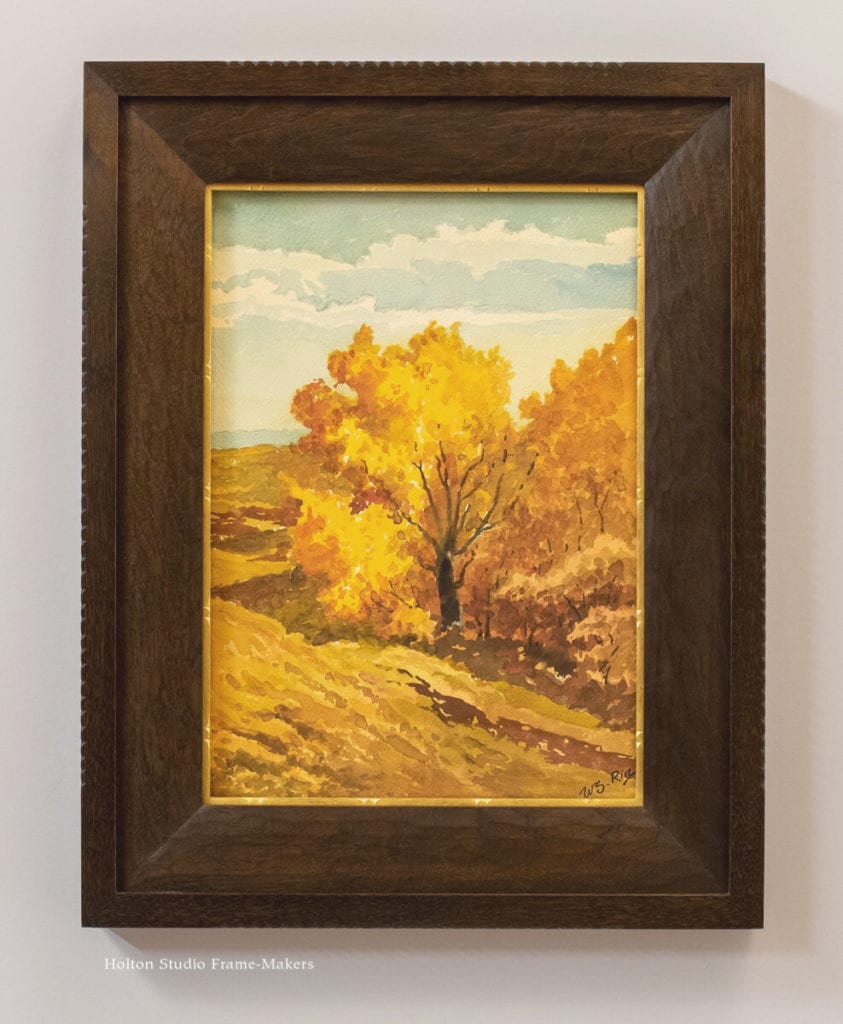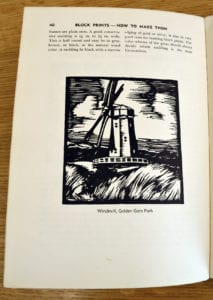A pantheon of great Bay Area artists would not be complete without William Seltzer Rice (1873-1963). Best known for his block prints, Rice also painted beautiful watercolors. We just framed one of each medium. First, the watercolor: “Autumn Leaves, Leona Canyon,” (ca. 1943; 10″ x 14″) is framed close in a 2-5/8″ wide stained walnut carved cushion compound frame with a carved gilt slip. The pattern of the leaves suggested the running pattern (which I did with a file) on the outside of the cap molding and the more sparse bead carved into the slip.
We’ve framed other Rice watercolors, three of which I posted together a few years ago, here.
And here’s the block print. Titled “Cresheim Mill—Autumn” (ca. 1930) it’s about 8-1/2″ square. The frame is our No. 14 CV Panels. The ends of the panels can be shaped any number of ways (No. 14 CV Scallops is a popular example), and for this one they are patterned after the jagged edges in the print. I enjoy using this frame for block prints because the frame itself is carved identically to how the printing block was carved. The frame is in stained quartersawn white oak with a pale gold slip.
Another Rice block print in a similar frame is in a blog post here, and one is in the Portfolio here.
I know—a bit odd posting two fall scenes on the third day of spring, but that’s just how it worked out!
“Block Prints: How to Make Them”—
William Seltzer Rice taught block printing in high schools and colleges, including the California College of Arts and Crafts, and published two books, Block Printing In the Schools (1929) and Block Prints: How to Make Them (1941). The latter one I picked up somewhere years ago. The illustrations alone make it worth having. They include this color plate of the artist’s “Old Bridge—Chartres,” which faces the title page. A new edition has been published by Pomegranate Press.
More pages from “Block Prints: How to Make Them”—
William S. Rice on “Matting and Framing Block Prints”—
The book’s brief chapter on “Matting and Framing Block Prints” is extremely basic, but does have two notable points (readable in the images below). One is the explanation for why the bottom of a mat should be weighted (i.e., made wider than the top and sides); and the other is the acknowledgement that there are block prints—albeit “exceptional cases”—for which “matts are not used,” i.e., framing close is best. Otherwise, the artist liked tiny, “conservative” moldings just 1/4″ or 3/8″ wide!
Annex Galleries, which is a good source for prints by William S. Rice, offers a good bio page for the artist…
« Back to Blog













